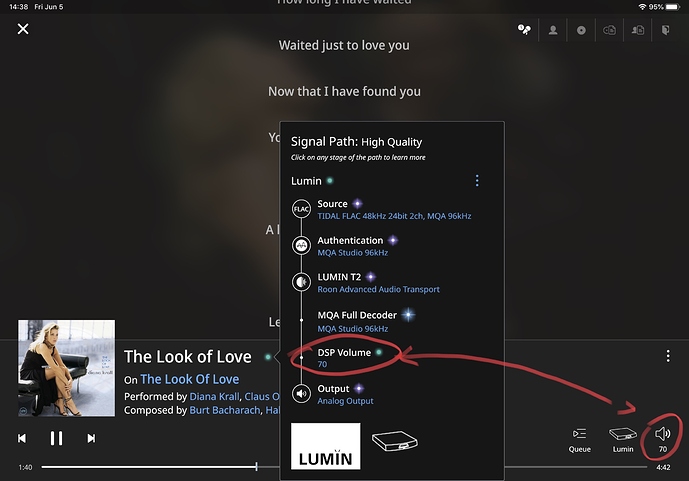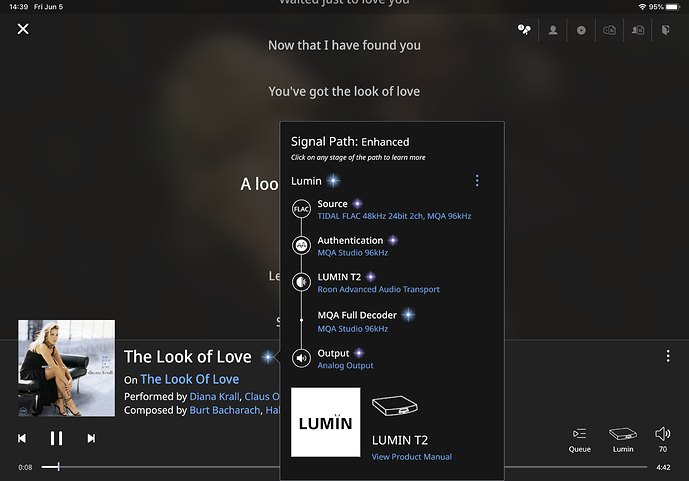Ok this worked thanks - thought apps refreshed and updated themselves automatically… Similar to what @AndersVinberg said, not too sure what it does. The default settings for this feature are ON and Max Volume set to 100%.
That can be controlled in iOS app store setting. (There’s also a similar setting for Android Play Store.)
Just about the speakers.
Are you comfortable sharing any plans with regards to integration of room correction DSP (preferably Dirac Live) into some of Lumin’s products (like network streamers)?
Thank you,
Philippe
We do not have the CPU power for room correction inside Lumin hardware. Please use Roon Core DSP.
Thank you. That helped, a little.
I’m not really convinced (not having heard it).
I have worked in computer graphics, initially with floating point math on big computers, but when the PC arrived it all became integer math because that’s all the CPU could do in real time. And that lead to a generation of engineers who thought that a line had to be an integer number of pixels wide. But that is clearly wrong, it leads to limiting decisions for algorithms. In a grown-up product like Photoshop, it is certainly possible to draw a line of 1.374953 pixels wide, at an angle of 77.4963 degrees from the horisontal.
What I read in these papers is that only integer math is acceptable, in terms of sound quality, and to preserve integer math they have come up with a clever algorithm to support a fixed set of volume attenuation ratios that can be expressed as fractions. That’s clever.
But it seems to me a step backward.
I’ll be intrigued to see how it performs in practice.
@brian comments?
@brian
I’m posting this because I added a note to you in my previous post, and I’m not sure if the forum software sends a notification on an edit…
Specifically what I mean with my comment about integer vs. floating point is that, just as in graphics, making a graphical element translucent by an arbitrary ratio used to be very advanced and available only in the most sophisticated software like Photoshop, today it’s used in many web pages, viewable on a phone. Similarly, in audio, Roon has enough compute power do do all kinds of processing, from DSP room correction to simple volume control, in 64 bit floating point.
It is true that at the end, the DACs don’t take floating point so Roon has to render the result in 32-bit or 24-bit integer. But that’s true for Photoshop too, the printers typically don’t take floating point, but the integer precision is sufficient to faithfully render images that have been created with floating point.
So that would be my concern here: we do have a technique that works really well provided you have enough compute power: Roon doing the processing in floating point and then rendering the result in 24-bit or 32-bit integer for the DAC. But as you say, endpoint devices may not have the compute power to do that.
So my question is, what is the purpose here?
- To allow volume control in a limited-power digital device while avoiding the limitations of primitive digital implementations?
- Is the claim that the integer-fraction processing sounds better than the floating point processing in Roon?
To put it in Lumin terms, one situation is when you have a signal from some primitive source, a CD player or an internet stream: does this provide improved sound quality?
The other situation is when playing Roon: as you say, Roon can be set up so that a volume control change in Roon leaves the RAAT signal unchanged and Roon tells the Lumin box what volume is desired, but Roon can be instantly changed to do its own volume control (in floating point) and leave the Lumin box at 100 %. So the question for this forum would be, how would those two configurations compare?
Here’s what I am seeing since the update…!
The DSP number seems to be fixed and can’t be changed.
image|689x481
The claim is that, as with any audio product, it sounds better.
It you accept the view (in the whitepaper) that DAC output can do no more than 21 bit of resolution (see Stereophile measurements), it may be a little easier to understand the rationale of it.
As with another controversial format, we give users the choice to listen for themselves and make their own decisions whether it sounds better to them. We even added a setting in the app for users to easily switch between Leedh Processing Volume and the standard implementation, e.g. in ES9038PRO in Lumin X1, ES9028PRO in Lumin T2, etc. We do not force the use of this volume, in the same way that we do not force the use of the filter associated with the controversial format for music not in that format - the same cannot be said for many DAC supporting that format.
If users find it to sound better, that’s great, as we paid money and time for it.
Even if they don’t find it to sound better, I also think we served a valuable purpose here.
I certainly am not suggesting any criticism of your decision here. And I won’t have an opportunity to evaluate it in a Lumin box anytime soon, don’t need more DACs.
I’m just trying to understand the technology and claimed benefit and context.
Updates: so far when Leedh is ON, I can hear a slightly improved image and the bass feels tighter… curious to read what others are hearing.
I am getting a better understanding of this new feature although I am not hearing any differences for now, more A/B testing this weekend  .
.
Here’s a screenshot with Leedh ON
Here’s another screenshot with Leedh OFF
I take it this is for users going directly to power amps or actives? Why would you use a digital volume in a high-end system if you have a pre or integrated amp as you will get better results using the amps volume. I get you can then use the remote but your attenuating volume essentially twice are we not? Or am I missing the point.
Page 5 of the 6moons article above:
https://6moons.com/audioreview_articles/lumin8/5/
All very good questions, thanks for sharing them.
I have one about Roon: is there a way to change the volume on the fly via Roon? I only found Headroom management, but that‘s a permanent setting. AFAIK there is no „slider“ to control the volume by Roon in real time - Roon is always sending that info to the endpoint (eg LUMIN) or DAC. Or did I miss something?
Hi,
some info on Roon’s DSP volume here: Device volume control which may be relevant
If you enable Volume Control setting in Lumin app, there should be a volume slider in Roon if you tap the Lumin zone icon (if I remember correctly - cannot check right now) in the bottom right hand corner of the Roon Remote app. Mute should also be there.
Yes, depending on the device setup, its the speaker icon in the lower right.
In some case the slider controls the device volume, can be done over USB connections if the device implements these extensions, plus some other devices (like my Meridian) that has special protocols for this. But it is obviously not part of a standard SPDIF connection.
You can also set up the slider to control Roon’s own, software based “DSP volume”.
Or if neither is enabled, there is no slider.
That’s what I was referring to, since Peter says the Lumin can be set up so that the new Leedh volume is controlled over USB, Roon could do that, or you can switch Roon to do its own DSP volume. In fact, I use a combination in my bedroom: my DAC has a remote control for its volume, but if I don’t want to reach out to get the remote, Roon’s volume is available on the iPad. No audible difference, in this (non-critical) system.
Anders, Peter, thanks for your answers. I formulated my question badly, so it could be misunderstood. I use the volume in Roon. It triggers the volume algorithm in the LUMIN. My question was if I missed an option to use an on the fly volume control from Roon DSP that could be triggered by the same slider. But this does not exist.
In the end I‘m very fine with the analog volume from the pre anyway 

